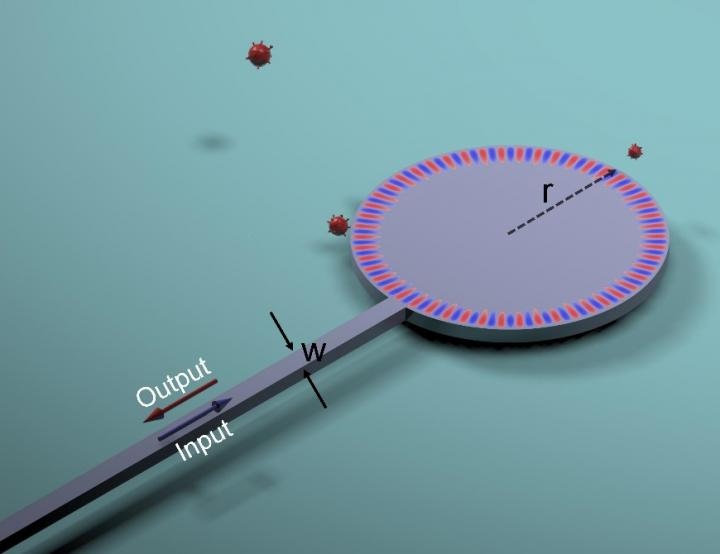May 21 2018
Practical chip-based sensors for use at the point of care to detect cancer and other illnesses are in great demand. A new ground-breaking method to inject light into miniature silicon microdisks could help meet this requirement by minimizing the cost and enhancing the performance of chip-based biosensors. The progress could ultimately result in a portable and economical optical sensor for early-stage cancer diagnostics.
 A new end-fire injection technique uses a waveguide (W) that is directly connected to the edge of the microdisk. A phenomenon known as laser time-reversal creates a laser that absorbs light rather than emits it, allowing the light to efficiently enter the microdisk, which use the whispering-gallery optical effect to confine and enhance light that enters the disk. (Image Credit: Qinghai Song, Harbin Institute of Technology in China)
A new end-fire injection technique uses a waveguide (W) that is directly connected to the edge of the microdisk. A phenomenon known as laser time-reversal creates a laser that absorbs light rather than emits it, allowing the light to efficiently enter the microdisk, which use the whispering-gallery optical effect to confine and enhance light that enters the disk. (Image Credit: Qinghai Song, Harbin Institute of Technology in China)
Microdisks are a type of microscale resonator that make use of the whispering-gallery optical effect to restrain and improve light that enters the disk. Just as the curved walls of a whispering gallery transmit sound waves to allow whispers to be openly heard across a room, the curved inner surface of a microdisk transmits light waves across the disk, improving the light. This allows the microdisk to increase a light-based signal coming from a protein, cell, or virus of interest, allowing more sensitive detection of minute changes related with diseases such as fibromyalgia, lupus, and certain heart complications.
Although there are whispering gallery mode micro-resonators that can already be used to resolve single molecules, their application is limited by problems in device repeatability, stability and wavelength range. Our new design enables excellent device performance that works with a variety of wavelengths with low cost, higher stability and better device repeatability.
Qinghai Song, Research Team Leader - Harbin Institute of Technology, China
In Optica, The Optical Society's journal for high-impact research, the scientists describe their new end-fire injection configuration, which offers a simple, economical and efficient way to direct light into the microdisk resonator. They also demonstrate that devices using microdisks and end-fire injection can be used to detect the presence of nanoparticles and temperature variations.
The researchers’ critical goal is to use their new end-fire injection method to develop a portable and cost-effective sensor that can detect variations in cells that are early signs of cancer. However, they highlight that the new light-coupling arrangement could also be beneficial for built-in photonic circuits for communication applications and a range of different sensors such as those used in environmental monitoring or homeland security.
Using Time Reversal
A majority of microdisks are built so that light is indirectly injected into the microdisk using an optical occurrence called evanescent light coupling. However, this technique requires very precise placement between the waveguide and the microdisk, which raises manufacturing costs and makes devices vulnerable to stability issues.
The researchers’ end-fire injection method utilizes a waveguide that is directly linked to the edge of the microdisk. Although light that is precisely perpendicular to the disk’s side will spring off the interface, using light angled just somewhat less than perpendicular prompts a counterintuitive occurrence called laser time-reversal. This forms a laser that absorbs light instead of emitting it, thus enabling the light to efficiently enter the microdisk.
“Because this configuration doesn’t require any parts that are smaller than 500 nanometers, it can be fabricated with low-cost techniques,” said Song.
The scientists fabricated a device to test their design. It contained a microdisk with a 5-micron radius connected to a waveguide.
To measure the end-fire injection, they integrated a Y-splitter that permitted light passing via the splitter to be injected into the microdisk and then be conveyed out of the microdisk along the same waveguide. Recording the spectrum emanating from the Y-junction revealed that light could be directed into the microdisk with an efficiency as high as 57%.
They also proved that the device displayed a high Q-factor, a measure of how well the microdisk restrains and amplifies the light. Furthermore, the device continued good performance parameters even with fabrication abnormalities such as increasing the waveguide width from 400 nm to 700 nm.
We show that the performance of the end-fire injection technique is comparable to that of conventional microdisks but with improved robustness and reduced cost. Overall, our findings show that microdisks are now ready for commercial applications.
Qinghai Song, Research Team Leader - Harbin Institute of Technology, China
The team also validated that sensors integrating microdisks and end-fire injection could detect the existence of several large nanoparticles as well as single nanoparticles as tiny as 30 nm. They are keen to use cell-derived vesicles that are about 40-to-100 nm to detect cancer, which should be viable based on these results.
The scientists are at present working on other parts of the device that would be required to use the end-fire injection method to build a portable and economical sensor that can detect early indicators of cancer.